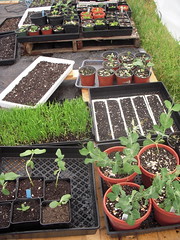Having a greenhouse will give many benefits to a gardener, whether he is a mere hobbyist or an expert plant cultivator. However, there are many things to consider in having a greenhouse, not to mention the expenses that come with building greenhouses.
A good alternative is to own a hoop house type of greenhouse. These are very simple greenhouses which can be assembled very easily. There are many advantages in having a hoop house greenhouse, here are some of them:
 Image by meganpru via Flickr-Availability of more growing time
Image by meganpru via Flickr-Availability of more growing time
A hoop house greenhouse provides a gardener more time to cultivate his favorite plants. An extra 3 to 4 months can be gained by planting more crops in the greenhouse.
-Inexpensive way to cultivate
Hoop house greenhouses provide an inexpensive way to help greenhouse enthusiasts to get started in cultivating crops - construction and materials are generally quite simple and affordable.
-Crop protection from predators and extreme weather conditions
Hoop house greenhouses are built to protect plants from different adverse conditions which can be brought about by weather conditions and different crop predators. They provide sturdy and efficient covering for the plants against these factors.
-More varieties of plants can be grown
Because hoop houses will allow longer growing seasons, more varieties of plants can be grown in the hoop houses.
-Increased income and savings
One can cultivate different crops which can be equated into additional income or savings. One can actually sell fruits and vegetables which are grown in the hoop houses or can plant crops which can be consumed by the family, therefore avoiding the need to purchase these from the supermarket.
There are many reasons why gardeners have adopted hoop houses for their gardens. Here are some more pertinent facts about hoop houses:
-Most growers recover the cost of building their hoop houses in a single season of planting.
-There are no permits required in building hoop houses since they are not considered as permanent structures.
-The growing seasons can be extended by using hoop houses. Hoop houses usually extend growing seasons by as much as 4 months, but by adding layers of insulating film and an inflation blower, one can extend the growing season by more than four months.
-Hoop houses are usually made from galvanized steel. The galvanized hoops serve as the framework for the greenhouse. The material is low maintenance, very sturdy and very economical.
-Hoop houses are characterized by natural regulation of its temperature. There is often no need for extra equipment which can be an additional cost. The hoop houses are warmed by the natural sun and are cooled by the wind. One can roll the sides up and open the hoop house doors to be able to provide ventilation to the plants inside as the season gets warmer. This is a very cost effective way of cultivating plants in a greenhouse.
-Hoop houses can often be built even in places where winds and snow are prevalent. Hoop houses are normally built from sturdy frames which are designed to handle heavy winds and can even withstand the harsh effects of snow. One can position the hoop house perpendicular to the winds to maximize the ventilation for the plants. One should also remember to do some maintenance when the snow comes. You may need to occasionally brush off the snow if it starts to accumulate, so that your plants can get sunlight. (However, if a hard cold snap is predicted, you may want to leave the snow on the hoop house for a couple of days to provide extra insulation during the cold spell.)
 Image via Wikipedia
Image via Wikipedia-Hoop houses can be built quite tall and gardeners can use the vertical space to be able to plant more crops. Adding purlins will allow one to hang baskets, tie up tomatoes and other plants. The baskets can then be used to plant ornamental crops or other types of plants.
-One can customize his hoop house in terms of the creation of doors or windows. The traditional hoop houses have a built-in door and a couple of windows for ventilation.
-There are other functions that hoop houses can fill when the planting season is over. They can serve as a chicken coop if one installs poultry netting. They can also be used to grow orchids or other ornamental plants.
-Hoop houses can be relocated easily. Relocating hoop houses can be done without disassembling the structure.
There are many reasons why people turn to hoop houses when they want to have a greenhouse. Aside from the multiple benefits that plants can get from being sheltered by hoop houses, these greenhouses are very economical and won’t dig deep into the gardeners’ pockets.
 Image via WikipediaAs mentioned, individual plants will require different amounts of water to keep them growing optimally. But what all plants do like is moist soil. If you are worried about over-watering your plant, make sure that the pot you choose has a good drainage system. With holes in the bottom of the pot or gravel inside the pot the soil and plant will soak up the necessary water and the excess will run out through the bottom. (See our previous blog post on choosing good pots for your indoor garden.)
Image via WikipediaAs mentioned, individual plants will require different amounts of water to keep them growing optimally. But what all plants do like is moist soil. If you are worried about over-watering your plant, make sure that the pot you choose has a good drainage system. With holes in the bottom of the pot or gravel inside the pot the soil and plant will soak up the necessary water and the excess will run out through the bottom. (See our previous blog post on choosing good pots for your indoor garden.)













